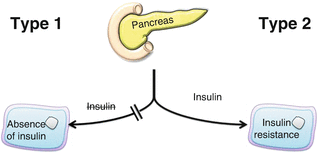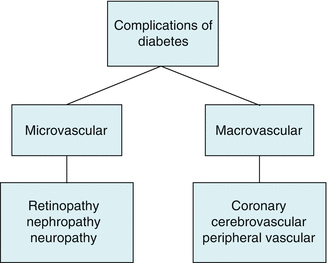and Christopher Isles2
(1)
Institute of Cardiovascular and Medical Sciences, University of Glasgow, Glasgow, UK
(2)
Dumfries and Galloway Royal Infirmary, Dumfries, UK
Q1 Describe the two types of diabetes and discuss the ways in which they differ.
Type 1 diabetes results from insulin deficiency, with usual onset in teenage or young adult life. It is around ten times less common than type 2 diabetes. Type 2 diabetes is a disease of the middle aged in whom it is usually a consequence of obesity. Far from being insulin deficient, these patients have high levels of insulin in their blood stream which is ineffective because they are overweight. This is known as insulin resistance. Type 2 diabetes can also be a consequence of steroid therapy, for example after renal transplantation. New onset diabetes after transplantation (NODAT) is associated with a high risk of vascular disease. Other types of diabetes that are recognised more often than before are Latent Autoimmune diabetes of Adulthood (LADA) and Maturity Onset Diabetes of the Young (MODY). LADA patients are not always overweight and may progress more rapidly to insulin therapy than is usual in type 2 diabetes, while MODY is a form of diabetes that develops before the age of 25 and does not always require treatment with insulin (Fig. 22.1).


Fig. 22.1
Insulin is required at a cellular level to permit glucose into most cells. Without this process, diabetes occurs. There are only two ways this can happen: (1) Insulin is not produced by the pancreas (left side), and so cannot act on the cellular receptors or (2) Insulin is produced (often at high levels), but the cells are resistant to its effects (right side). The left is type 1 diabetes, and the right type 2
Q2 Describe the complications of diabetes
These are usually considered under two headings – microvascular and macrovascular as shown in the diagram. Diabetes accounts for 1 in 7 of all deaths in the UK. The majority of these are cardiovascular. Diabetes is also the commonest cause of CKD in the UK (Fig. 22.2).


Fig. 22.2
Complications of diabetes
Q3 What do you understand by the term diabetic nephropathy?
Diabetic nephropathy is the classic cause of CKD in people with diabetes. It occurs in up to 40 % of patients after 15–20 years and is more common in those with poor glucose control. It is as likely to occur in type 2 diabetes after 15–20 years though the risk to the individual is greater in type 1 diabetes because type 1 s generally have the disease for longer. The clinical hallmark of diabetic nephropathy is proteinuria and the pathological hallmark is glomerulosclerosis. Figure 22.3 shows how diabetic proteinuria may evolve over a number of years.


Fig. 22.3
Progression of proteinuria in diabetes
Q4 Do all patients with diabetes and renal impairment have diabetic nephropathy?
The triad of diabetes with proteinuria and retinopathy means that the renal disease is almost certainly due to diabetic nephropathy. Most patients with type 1 diabetes who develop proteinuria will have diabetic nephropathy. By contrast, patients with type 2 diabetes and renal impairment often have little or no proteinuria (urine PCR <100 mg/mmol). This type of diabetic renal disease is seen particularly on those who have hypertension and vascular disease at other sites. This is probably due to narrowing of the small arteries in the kidney, so-called hypertensive nephrosclerosis (see Chap. 23).
It is also true that up to 50 % of type 2 diabetics who do have proteinuria will have other forms of proteinuric nephropathy such as FSGS, membranous nephropathy or minimal change disease. In clinical practice this is unlikely to influence management unless nephrotic syndrome is present, raising the possibility that steroids (minimal change and FSGS) or steroids and cyclophosphamide (membranous nephropathy) may be indicated. For these reasons it is not common practice to biopsy a patient with type 2 diabetes and proteinuria unless nephrotic syndrome is present (Fig. 22.4).






Fig. 22.4
Presentations of renal disease in diabetes by degree of proteinuria
Q5 What can be done to slow the rate of progression to renal failure in patients with diabetic nephropathy?< div class='tao-gold-member'>Only gold members can continue reading. Log In or Register to continue
Stay updated, free articles. Join our Telegram channel

Full access? Get Clinical Tree








